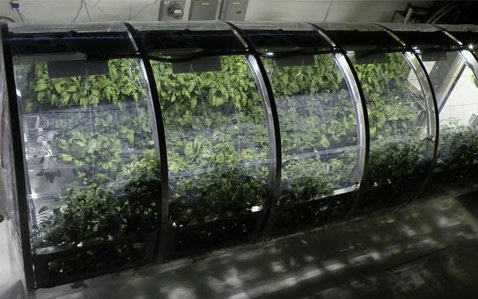
It’s been said that a camel is really a horse that has been assembled by a committee after much discussion and lots of diverse input.
But sometimes great minds do think alike as in the case of the recent Controlled Environment Indoor and Vertical Food Production Coordinated Research Conference held at Southern Arizona’s world-famous Biosphere2 research laboratory.
Sponsored by the Department of Agriculture; its subsidiary NIFA (National Institute of Food and Agriculture), and the University of Arizona Controlled Environment Agriculture Center, over 100 attendees of all stripes --- from growers and governmental entities to students and researchers --- met for 4 days to come up with a master plan designed to help in the goal of feeding a hungry planet.
“Open field agriculture in the U.S. is the largest in the world aimed at feeding the largest number of people, but there are limitations in land, labor, and resources,” said co-coordinator Gene Giacomelli, estimating that the current greenhouse-grown vegetable effort represents slightly more than 1.3 million acres under glass.
“We want to compliment that food production capability by solving some of the problems of indoor growing to produce greater yield and enhanced nutrition.”
Plenty Inc. of San Francisco was one example in the form of keynote speaker Nate Story, Chief Science Officer and co-founder of the 2013 start-up funded in part by $200 million in backing from investors like Amazon’s Jeff Bezos.
EMERGING INDUSTRY
Already touting that Plenty is “Where Nature Meets Nurture” and promising to close the global nutrition gap, Story said his indoor grow efforts represented “an emerging industry trying to control costs while bringing high quality product to market --- a difficult thing to do. We need to focus on research in order to help the industry drive value up and cost down by being both systems- and crop- specific.”
Story called plants “the smartest creatures on the planet because they have figured out how to make humans their slaves by domesticating them and spreading them all over the world. Once we understand the economics of indoor agriculture, this industry is going to be a boon for humanity.”
Over the course of the conference, 33 speakers told of their research successes and remaining problems in trying to grow things better, faster, and cheaper with discussions ranging from nutrition and post-harvest concerns to production systems and pest and disease management.
Audience interest was piqued with presentations on new technologies in plant breeding and how feeding folks in outer space may provide some suggestions on how to better accomplish that mission on the ground.
Noting that plant breeding has been around since the early days of crop domestication, Gail Taylor, Plant Sciences Chair at the University of California, Davis campus said the process took a quantum leap once DNA was explained.
“Today, generally involving big crops in outdoor environments and refinements in programs involving disease, pest management, stress tolerance, and increased yield, there’s a lot going on there, and by snipping away at plant DNA, adding to or taking away from, we can make new products that both outdoor field and indoor vertical farming can take advantage of.”
BREEDING SUCCESSES
Citing breeding program research successes like uncovering a gene that allows peppers to be more easily harvested mechanically to extending the shelf life and increasing the antioxidant properties of lettuce, Taylor said that modern breeding techniques allowed a new start to improving nutrition, flavor, and yield.
While some breeding successes have been noted in dwarf or super-dwarf crops as well as those that are more robotics-ready for mechanical management, the search continues for more vigorous, rapid, high-yielding traits that are faster flowering with a shorter life cycle and more efficient use of nutrients and depleted carbon dioxide.
Genetics research is on-going to produce plants with more appropriate architectures that will lend themselves to more efficient mechanical supervision and harvesting, produce that will maintain a longer shelf life, as well as crops that are cleaner because of less chemicals and healthier because of secondary phytochemicals.
“We struggle with the same issues that greenhouse growers and indoor vertical farms do in looking at food security, keeping astronauts operating at peak performance on long-duration missions,” said Ralph Fritsche, Senior Crop Project Manager in NASA’s Life Sciences Office.
Earlier space missions where crews were kept busy at work stations on their way to the moon didn’t have much time to plant something and grow it to harvest, but longer duration flights like those to Mars will allow the growing of plants, much of it done by automation as is happening in today’s terrestrial indoor and vertical grow efforts.
“Right now, NASA is taking from current CEA knowledge and technology with a pay-if-forward mentality. Once we find solutions to similar problems in space, light bulbs will light up in the CEA industry on how these answers can be applied on earth.”
HURDLES FOR FRUIT
Based on the presentations, nearly half of the attendees contributed concepts to a grant application workshop involving funding opportunities to support further research.
“Most of the currently-funded projects deal with leafy greens, but there are still major hurdles for profitable production of fruiting crops,” said Dr. Kai-Shu Ling of the USDA Vegetable Laboratory.
“We will work together to prepare, hopefully before the end of the year, a proposal for submittal to the USDA/NIFA Specialty Crop Initiative Research program to establish a coordinated agricultural project for controlled environment agriculture research, a roadmap for indoor food production agriculture in the United States,” said Ling.
To which Giacomelli added: “This report, interfacing all seven themes of the conference, will not be a report that gathers dust.”
About the Author(s)
You May Also Like




